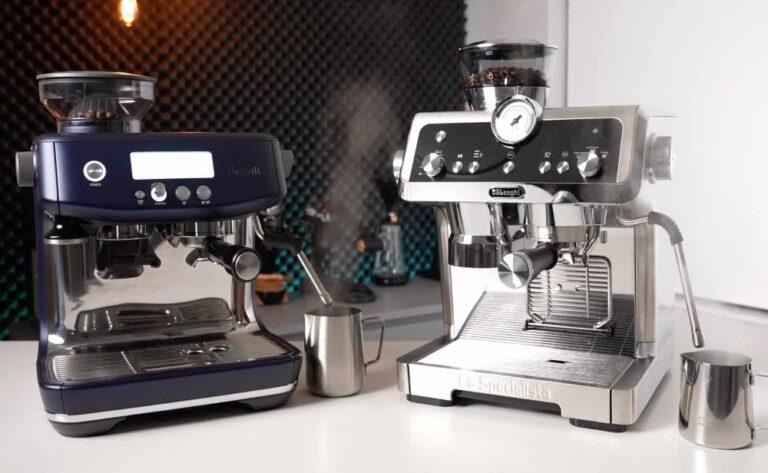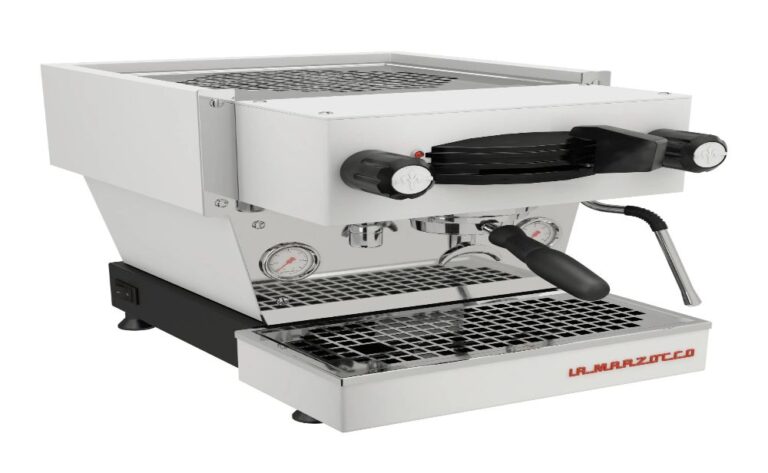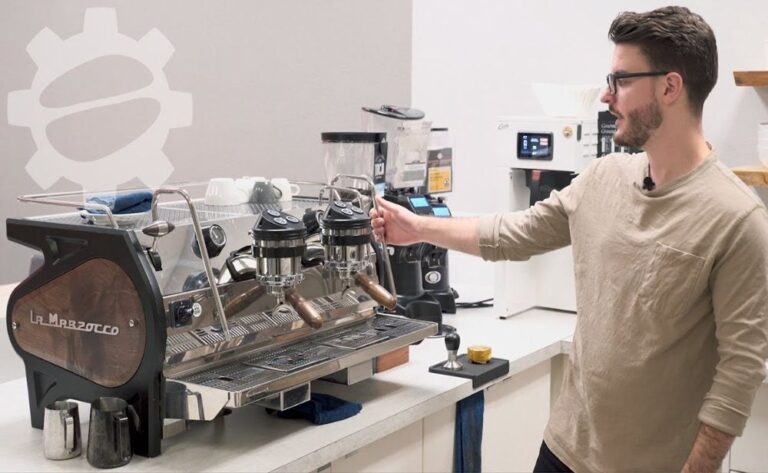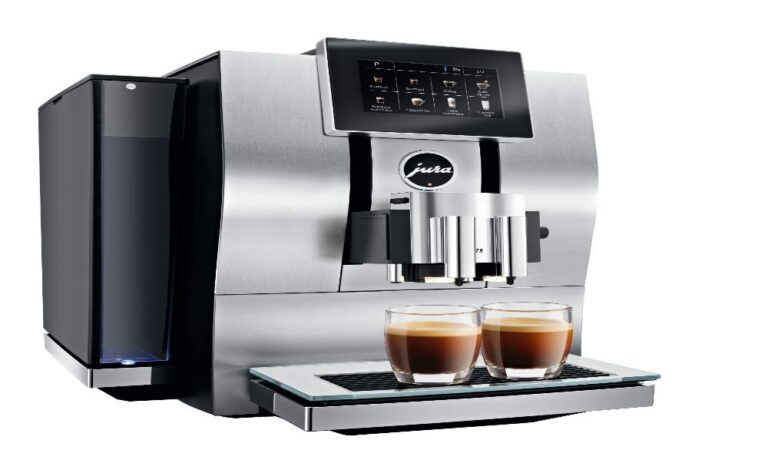
When I say that the Rancilio Silvia is possibly the most well-known household espresso machine available today, I’m not exaggerating the statement in the least. There are only a few other models that share a history even remotely similar to this one.
In spite of this, the fact that it is a well-known machine that has been around for some time does not necessarily indicate that it produces outstanding coffee when measured against the high standards of today.
After all, the Silvia didn’t make its debut until the year 1997.
That was a quarter of a century ago.
To our good fortune, Rancilio has maintained a steady schedule of equipment upgrades throughout the years. In preparation for this review, I put the newest model, the V6, through its paces.
Continue reading if you are interested in finding out whether or not this model still has what it takes.
After having her facelift in 2020, Miss Silvia looks even more stunning than before. This model offers a substantial amount of metal for the price that you pay.
ABOUT THE MANUFACTURER
Roberto Rancilio established the Rancilio coffee company in Milan in the year 1927.
This firmly establishes the company as a pioneer in the production of espresso in northern Italy, right up there with Bezzera, Gaggia, and La Pavoni.
It may be hard to believe in this day and age, but preparing espresso at home is a relatively recent development. Rancilio and all of its competitors in Italy concentrated entirely on the production of commercial equipment.
However, in 1997 Rancilio developed a miniature replica of their professional equipment as a thank you gift for the company’s business partners. This gift was a miniature version of the Rancilio Professional Espresso Machine.
A few years later, this espresso machine, which would subsequently be dubbed the “Silvia,” would be made available to the general public.
The Silvia has had numerous revisions since its introduction by Rancilio, and the most recent one, version 6, was released in the year 2020.
A more recent development from Rancilio was the introduction of a “pro” version of the Silvia. It is fair to state that this machine is completely different on the inside thanks to its two boilers and its PID, despite the fact that they share certain cosmetic similarities. Let’s concentrate on the first version for the sake of this critique.
DESIGN & BUILD QUALITY
The Silvia is a condensed and boxy piece of equipment. Although there is nothing about the espresso machine that could be considered feminine, it is commonly referred to by coffee enthusiasts as “Ms. Silvia.” This has always seemed strange to me.
Other Italian design classics like Vespa scooters or Ascaso espresso makers suggest something that could be considered as moving in that direction. [Citation needed] Nevertheless, the Rancilio Silvia, at least in my opinion, comes out as rather brutalist or maybe merely functionalist.
That, however, does not imply that it is an unattractive piece of machinery. On the other hand, the most recent version has been updated with new button icons and a black group head, which gives it a more contemporary appearance. This change was made in the most recent release.
PREMIUM ACCESSORIES
After recently evaluating two of the machine’s most significant competitors, the Gaggia Classic Pro and the Breville Bambino Plus, I have to declare that the Silvia is superior to both of them when it comes to the sensation of quality and durability when you compare them head-to-head. In terms of photogenicity, I find the Gaggia and Breville models to be superior. In spite of this, I have to give the win to Rancilio Silvia because of the quality of the materials and the way they give you the impression of purchasing a premium product.
The drip tray of the Rancilio Silvia is composed of metal, and it gives the impression that no expense was spared in its construction. For instance, there are various grill patterns under the brewing parts and the steaming sections to account for the difference between steaming the coffee at a high pressure and slowly dripping it into the cup. In comparison, the entry-level machines offered by Gaggia and Breville feature an abundance of plastic that has a distinctly low-quality feel to it.
The portafilter and the tamper are further indicators of the quality and heft, respectively. This portafilter is much heavier than those offered by Breville and Gaggia in the same price range, and it has the sense of a commercial product, if that’s even possible to say.
In the same way, this also applies to the tamper. However, power users will soon wish to switch to a precise tamper, despite the fact that it has a heavy-duty construction.
INTERNAL DESIGN
On the inside of the Rancilio Silvia, a few upgrades have been made, including the installation of an insulated boiler and a new power saver button that turns the machine off after it has been inactive for half an hour. The word “ecological” is represented by the letter “E” in the company name.
Aside from that, the machine is uncomplicated and of high quality, just as it has been for many years. Because it includes a spacious 300 ml brass single-boiler and a 3-way solenoid valve, the puck that is left behind after a shot is less untidy and less wet than it would be otherwise.
During the time that I was testing the machine, I didn’t feel the need to mess with anything inside of it; but, according to the stories of those who work on Silvias for a living, the machine is well-made and has the potential to survive for a very long time. If there is a problem, it is something that can be fixed by the individual.
IN DAILY USE
The Rancilio Silvia only has one boiler, which is used for both steaming and brewing coffee. Because of this fact, your interaction with the machine will be constrained and controlled in the same way.
Espresso should be brewed at a temperature of approximately 200 degrees Fahrenheit (93 degrees Celsius), while creating steam calls for even greater temperatures.
Therefore, a single boiler needs to be able to go between some very significant extremes in temperature and pressure. Because of this, in order to obtain the finest results with the Silvia, you are going to need to engage in a technique that is known as “temperature surfing.”
It may appear to be an exciting and entertaining pastime, but in practice, it is significantly more laborious than it first appears to be.
TEMPERATURE SURFING EXPLAINED
Imagine for a moment that you have the need to prepare a cappuccino.
• To begin, you pull your shot like you would normally anticipate.
• However, you will need to wait for the boiler to reach the desired temperature, which might take up to a minute and a half. Although it might not sound like a very long time, during that interval, the crema from the shot will begin to lose its intensity.
A comparison can be made between this pause in action and the minute spent in the microwave. It simply seems to last far longer than the allotted amount of time.
You can, of course, do what many other Rancilio users do, which is:
1. Start with the steam
2. After that, make some tea
On the other hand, I’m not a huge fan of this workflow for a number of reasons, including the following:
• In order to bring the boiler up to the appropriate temperature for brewing, you will need to evacuate a significant quantity of water and steam. It seems like effort that isn’t essential.
• Purging might be a pricey endeavor in the long run, particularly if you purchase a certain brand of bottled water or soften the water on your own in order to safeguard your device.
• Additionally, if you want to pour latte art, you need to continue grooming your milk while simultaneously dealing with the temperature and preparing or pulling the shot.
I’m not suggesting that it’s impossible to become an expert at this and figure out a decent workflow (I’ve seen videos of people doing it on YouTube), but I find it to be a little bit complicated and cumbersome.
MAKING TASTY SHOTS?
Obviously, if you are going to be preparing a lot of milk-based beverages, you will notice this process more. Then there will be a lot of surfing in both directions.
But what if espresso is your primary beverage of choice? Although it is an improvement, you will still need to do some temperature adjusting in order to be comfortable. A PID temperature controller, used in more recent espresso machines, will provide exceptional temperature stability down to a single digit. This is possible with these controllers.
However, because the Rancilio Silvia is equipped with a thermostat, the temperature of the brew will repeatedly vary both above and below the set point. Therefore, in order to brew at the same temperature each time, it is necessary to expel some water and then wait for the boiler to reactivate itself before beginning the brewing process. After it has been turned off, you may immediately begin the brewing process, and you should end up with a very temperature-stable shot.
It might seem like a lot of work at first, but after you’ve used the machine for a week, you’ll get the hang of it quite quickly.
In addition to that, I’ll let you know that you’ll be rewarded with some mouthwatering images. If you warm the portafilter up in the group head, you can get greater temperature stability with the bulky 58 mm portafilter. When utilizing a commercial basket that is 58 mm in diameter, you have the ability to get a very fine grind.
Therefore, in general, when you get a shot correctly, it tastes extraordinarily wonderful and is on par with the quality of coffee served in the vast majority of coffee shops.
I will also mention that the boiler is a generous size, coming in about 300 litres. This means that you won’t have to worry about brewing at lower temperatures just so you can make a good lungo or “sprover.” Instead, you’ll be able to do both.
During the testing time, I used a grinder that was outfitted with SSP Multipurpose burrs, and the light-roasted 1:10 shots that I pulled tasted fantastic.
THE STEAMING OF MILK
I’m not much of a latte artist, and when I do produce some, it usually has a Salvador Dali vibe to it and is a little bit abstract. On the other hand, the Silvia is a fantastic piece of equipment to learn on if you are interested in getting into this facet of coffee manufacturing.
It possesses a significant amount of steam power. If you ask me, there is nearly an excessive amount of it. I was taken aback by the explosion that repeatedly burst from the steam wand, which caused a mess to be made on the kitchen counter that needed to be cleaned up.
Because the Rancilio Silvia V6 E that I used for my test produced steam that was even more powerful than the Breville Dual Boiler that I often use, I believe that it is accurate to claim that it provides both enough and more than you require.
However, this enormous quantity of potent steam does not come without a cost, and as a result, the process of going from brewing to frothing takes a little bit more time than usual. The Gaggia Classic Pro, which generates less steam in a shorter amount of time, has a quicker transition time between the two modes. This is because the Gaggia Classic Pro generates less steam.
EASE OF USE
When taken as a whole, I would not characterize the Rancilio Silvia as an easy-to-use machine. Because of the temperature surfing and the forceful steam, it is a tool that requires considerable skill before it can be used well. However, in this day and age, when we are accustomed to having things at our fingertips and are surrounded by technological advancements, it is inevitable that people may have contrasting reactions to the experience.
Making excellent espresso and other coffee drinks is already a difficult task in and of itself; however, this difficulty is amplified when working with a machine like as the Rancilio Silvia.
You’ll have a rewarding coffee adventure with the Silvia, especially if you want a passion and plan to spend some time on coffee forums and watching latte art instructions online.
Steer clear of this machine if, on the other hand, you want to get up in the morning, push a button, and have a latte ready for you with as little work as possible.
People who already have or have plans to acquire a burr grinder designed exclusively for espresso are the target audience for this particular model of espresso machine. People who aren’t put off by acronyms like RDT, WDT, TDS, and EY should feel comfortable using this service.
ALTERNATIVES
GAGGIA CLASSIC PRO
I believe that the vast majority of customers who are contemplating purchasing the Rancilio Silvia will also want to investigate the Gaggia Classic Pro.
The price difference between these two machines isn’t particularly large in Europe; but, the gap between them can be quite substantial in some other areas. Consequently, in the event that both of them fall within the same price range (less than 25%), I will most likely go with the Silvia.
Despite this, the Gaggia Classic Pro does have a few redeeming qualities, including the following:
The new coloring lends it an air of refined sophistication while also making it more compact. If we’re only talking about one cappuccino at a time, this machine offers a far quicker transition between the brewing and steaming stages, which makes for a more efficient workflow.
When examined more closely, the Gaggia, on the other hand, gives the impression of being of lower quality and is more fragile. The plastic components are not as aesthetically pleasing, and the machine as a whole possesses less power and a more compact boiler.
The Breville Bambino Plus is yet another model that is available for purchase at a price that falls within this range. It stands in stark contrast to the Silvia V6 in a number of important respects. On the other hand, in my estimation, it is merely a significantly more contemporary machine that features an improved workflow.
Because this device utilizes a thermocoil and is equipped with a PID, there is no need for you to be concerned about the temperature. This is the piece of equipment that I would suggest to the vast majority of folks. If a person wants a quick milk drink but has zero interest in reading about coffee online, then this is the item that they should acquire.
Yes, the Silvia has a higher ceiling, and if you put it in the hands of a barista champion, you will be able to produce a better cup of coffee with it. In practice, however, the Bambino Plus will provide superior beverages with significantly less labor.
CONCLUSION
There’s something peculiar about the Rancilio Silvia V6. On the one side, it’s quite cumbersome and difficult to operate. On the other hand, I can’t help but think that for the price, you receive a substantial amount of premium steel and a high level of quality.
It is a dependable machine that, when operated properly, is capable of producing excellent espresso.
However, for most individuals living in the modern world, the fact that there is only one boiler and no PID should be a deal-breaker. I wouldn’t recommend this machine to my aunt or to someone who is only mildly interested in coffee. They wouldn’t get enough out of it. They would be considerably more satisfied with the results if they used a Breville Bambino. Or even a machine that makes Nespresso coffee.
On the other hand, if you are already a serious coffee connoisseur or are on your way to becoming one, it is highly probable that you will want to upgrade to a heat-exchanger or a dual boiler in the near future. Therefore, you could say that the Rancilio Silvia is also seated between two chairs in this metaphor.
There is no shadow of a doubt that this is a high-quality piece of machinery. But, alas, it is rather analogous to owning a Mercedes with a manual transmission in this day and age of Teslas.





